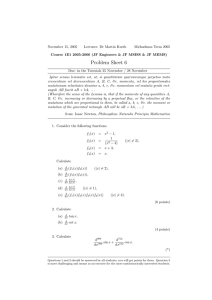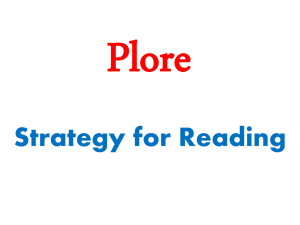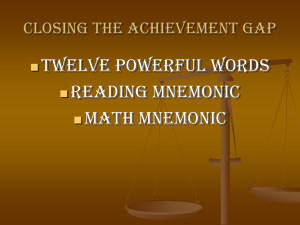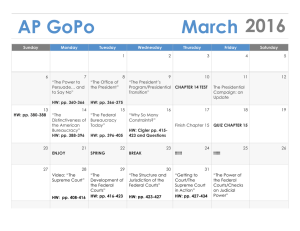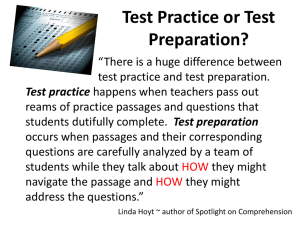UNRAAVEL Reading and Math
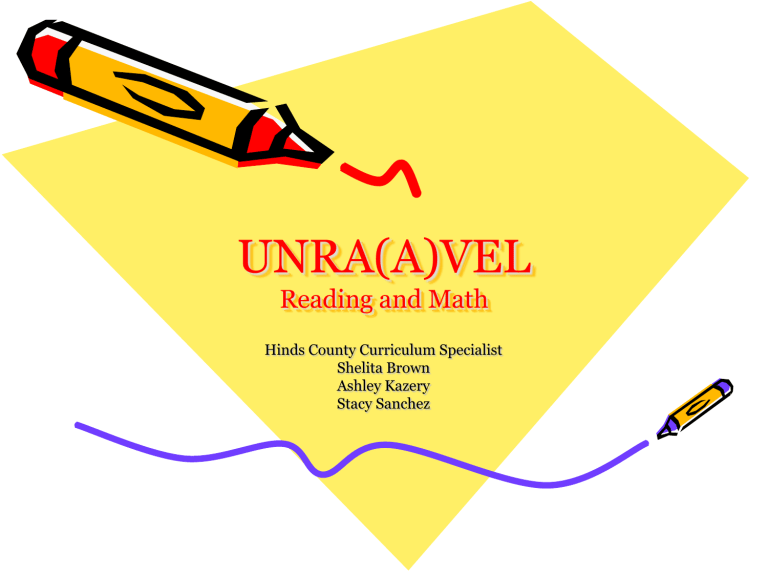
UNRA(A)VEL
Reading and Math
Hinds County Curriculum Specialist
Shelita Brown
Ashley Kazery
Stacy Sanchez
Reading
• Common Core requires the progressive development of reading comprehension
Reading UNRA(A)VEL
• Helps learners break down long reading passages in a manner that makes them much easier to understand.
The steps of UNRA(A)VEL
• U nderline the title.
• N ow predict the passage.
• R un through & number the paragraphs.
• A re you reading the questions?
• A re the important words circled?
• V enture through the passage.
• E liminate incorrect answers.
• L et the questions be answered .
U
nderline the Title
• Most readers skip over the title.
• Helps students prepare for what they are about to read.
• Allows students to begin making connections.
N
ow Predict the Passage
• Helps students to begin connecting the passage with what you already know.
• Helps guide students reading and keeps them focused as they test their prediction.
R un through & number paragraphs
• When students locate answers, they can write the paragraph next to the question quickly.
• It helps students organize the text on the paper and in their heads.
A
re you reading the questions?
• Helps students focus on the important information.
• Saves students time so they don ’ t have to hunt for answers.
• Use the numbered paragraphs to help locate answers quickly.
Are
the important words circled?
• Circling important words helps students locate the important information quickly.
• Circling important words also helps students stay focused on the reading.
V
enture through the passage
• This is the fun part of reading. Enjoy the passage.
• It might help if students write connections in the margins to keep them focused on the text.
E
liminate incorrect answers
• Eliminating incorrect answers makes it easier to locate the correct answer.
• Eliminating incorrect answers allows students to have less choices in case they are unsure of the correct answer.
L
et the questions be answered
• Using all of the previous steps, answering the questions should be a piece of cake.
• Students should always double check that they answered each question.
• 1. D
• 2. C
• 3. C
• 4. A
How did you do?
UNRAAVEL IT!
• Although this seems like it will take valuable test time away from students, it will do the complete opposite.
• The more students practice it, the quicker it will become and the better their test results will be.
UNRAAVEL a Math
Problem
Bolton-Edwards Math Geniuses!
and their Genius Teachers!
Montague (1997) found few students enjoy problem solving for reasons ranging from academic and social behaviors, motivational levels and self-perception.
Larry Bell’s
Math UNRA(A)VEL
For more than 13 years, this logical, concrete and sequential method has helped thousands of struggling learners successfully solve math word problems.
MP1 Make sense of problems and persevere in solving them
The aim is to get students to
KNOW math and not just DO math. – Marilyn Burns (2013)
We can not use UNRA(A)VEL as an algorithm for success. UNRAAVEL must be explicitly taught, practiced and even assessed with a conceptual understanding of each of the steps.
UNRA(A)VEL helps students make their thinking visible.
-Dr. Cathy Cavanaugh
UNRAAVEL Math
• U- underline the question
• N- now predict what you need to solve it
• R- read the word problem
• A- are the important words circled
• A- apply the steps you chose to solve it
• V- verify your answer (does it make sense)
• E- eliminate wrong answers
• L- let the answer stay or rework it
U = Underline the question
•Find the question and Underline it!
The question is the
PROBLEM.
Tip: Have students to rephrase the question in their own words. So what?
Sid has $50.00. He bought two video games that cost
$14.00 each. He also bought a poster for
$5.69. How much money did he have left after his purchases?
Albert Einstein wrote that he was asked if he had one hour to save the world what would he do?
“I would spend 55 minutes finding the problem and 5 finding a solution.”
-
Amazing Secrets to Problem Solving
N = Now Predict
What information do you think you need to solve the question/ problem
(numbers, pictures, bar modeling)?
What operations/ methods do you think you will you need to solve the problem?
R = Read
each line of the
Word Problem
Locate the important information in the text.
(consider the predictions)
UN
RA
(A)VEL
(These two steps generally work together)
A = Are
the Important
Words/ Numbers and their meanings
Circled? ( especially the operational words?)
•Sid has $50.00. He bought two video games that cost
$14.00 each. He also bought a poster for $5.69. How much money did he have left after his purchases?
CAUTION!!!
Mitchell (2013) and NCTM agree that using key operational words should not take priority over making sense of a problem, but instead treated as potential clues to solving the problem
(i.e. brought, each).
A = Apply
the Steps You
Chose to Solve the Problem
•$14.00
•X 2
$28.00
Video Games
$28.00
+ 5.69
$33.69
Video Games Plus Poster
V = Verify
Your Answer.
(
Is it reasonable? Does it make sense? Revisit the question. What information is being used to support the response?)
$16.31 is reasonable because it is smaller than
$50.00. It would make sense to have this amount left after buying games and a poster.
E = Eliminate
Wrong
Answers.
•a. $66.31
•b. $15.00
•c. $55.76
•d. $16.31
Too big. Conceptual
Procedural
Too big. Conceptual
Caution students against eliminating answer choices hastily. Sometimes they eliminate the right answer.
Remind them at times they may have to revise their thinking based on the text.
L = Let
the Answer Stay or
Rework the Problem
I got that one correct, but I may have to rework the next one!
1. Check the calculations
2. Reread the question and revise the steps
How far are YOU willing to go to see your student soar?
▶ UNRAAVEL - YouTube [720p].mp4
▶ Rainbow Unraavel - YouTube
[720p].mp4
Inspire someone today, change the world…
-Shelita
Teach with purpose.
